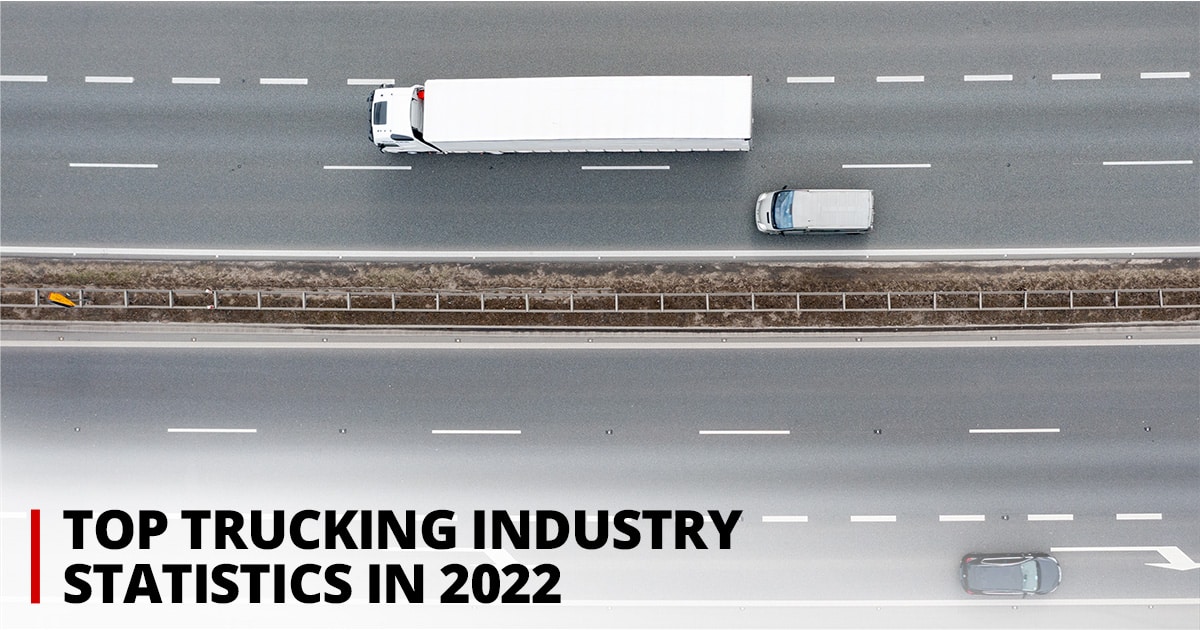Let’s take a look into the top trucking industry statistics for 2022. There are lots of interesting numbers and improvements from 2021.
The trucking business in the United States is one of the greatest revenue generators in the economy, moving 70% of all goods in the country. The entire revenue of the industry was $791.7 billion in 2019. Aside from commodities delivery, the trucking business employs millions of people, accounting for around 6% of the country’s employment.
Despite the fact that the industry is a vital part of our economy, a number of variables are beginning to influence its performance. We may witness a transformation in the way this business operates as a result of persistent driver shortages and the rise of self-driving trucks. Continue reading to learn about some crucial trucking industry statistics, including present conditions and future estimates.
Trucking Industry Facts and Figures
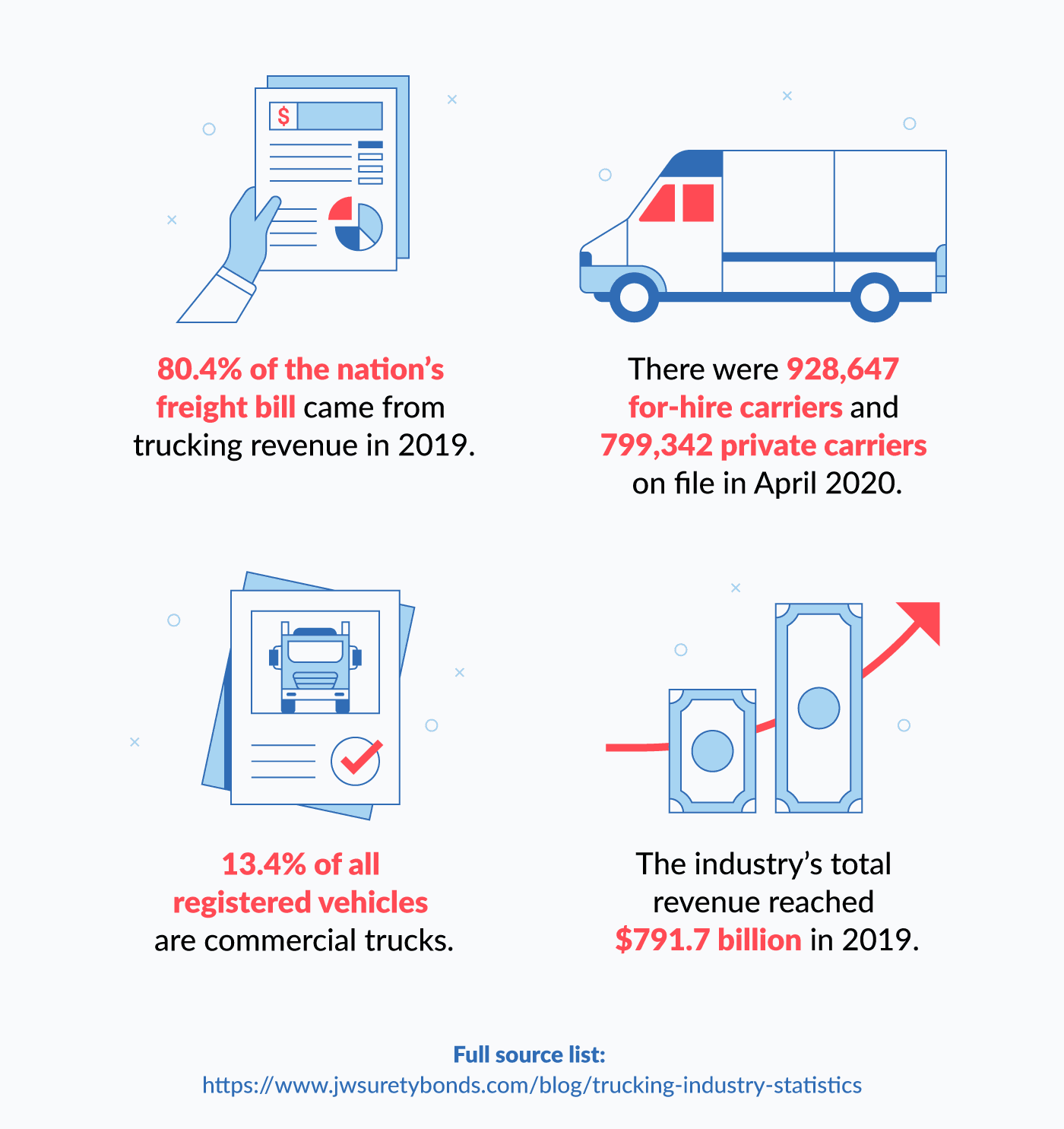
Without the trucking industry, our nation would not be the same, as it’s an essential industry that helps keep us afloat. Since the trucking and freight industry is such a lucrative source of income for the nation’s economy, a lot of businesses rely on it for their everyday operations. The industry represents more than half of the nation’s freight bill, and without it, our economy would suffer. For-hire carriers and private carriers make up most of the nation’s trucking companies.
- In 2019, 80.4% of the nation’s freight bill came from trucking revenue.1
- There were a total 928,647 for-hire carriers on file in April 2020.1
- In April 2020, there were a total of 799,342 private carriers on file.1
- 13.4% of all registered vehicles are commercial trucks.2
- In 2019, 3.91 million Class 8 trucks were in operation.2
- The total number of trucks registered and used for business reached 36.9 million in 2018.2
- According to the most recent report, commercial trucks paid $18 billion in federal highway-user taxes in 2018.2
- Commercial trucks paid $27.7 billion in state highway-user taxes in 2018.2
- As of January 2019, 24.44¢ of federal fuel tax was used to pay for each gallon of diesel fuel.2
1American Trucking Association: Trucking Moved 11.84 Billion Tons of Freight in 2019
2American Trucking Association: Economics and Industry Data
Transportation and Moving Stats

The trucking business is in charge of carrying commodities across the country as well as to our neighboring countries. Freight trucks transport a wide range of consumer items, including everything from food to automobiles, as well as raw materials and oil. Every good in the United States has been on a truck at some point during its voyage, according to the American Trucking Association.
- The trucking industry transported 11.84 billion tons of freight in 2019.
- In 2019, trucks moved a total of $772 billion in freight.
- Trucks transported 67.7% of products between the United States and Canada in 2019.
- Trucks moved 83.1 percent of cross-border trade with Mexico in 2019.
- Trucks hauled 72.5 percent of freight moved in the United States in 2019.
- In 2019, trucking moved 11.84 billion tons of freight, according to the American Trucking Association.
- American Trucking Association: Industry Data and Economics
Employment Demographics and Compensation
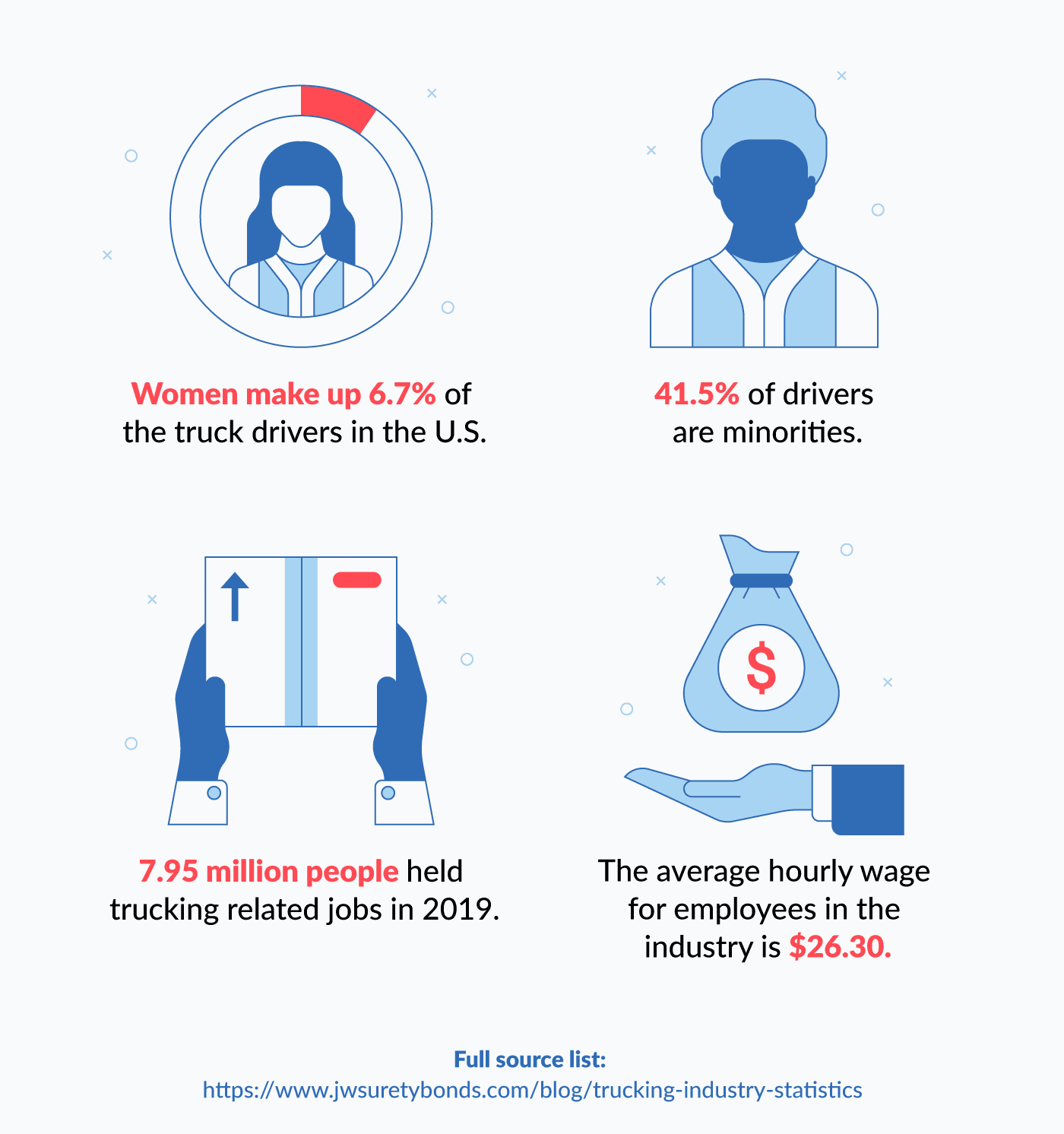
It’s no secret that the trucking sector employs a disproportionately male workforce. Despite the fact that it is a racially diverse sector, there has only been a two percent rise in the number of women employed in the last 18 years, and recruiting female drivers remains a challenge. In comparison to other industries, the average median income in the business is not highly competitive, which may contribute to the high turnover rate and difficulty in recruiting drivers.
Trucking Industry Statistics on Employment
- There were 3.6 million truck drivers in the United States in 2019. (American Trucking Association)
- In 2019, 2. 7.95 million people worked in trucking-related jobs in the United States. (According to the American Trucking Association)
- Women make up 3.6.7 percent of truck drivers in the United States. (According to the American Trucking Association)
- Minorities account for 41.5 percent of truck drivers. (According to the American Trucking Association)
- Drivers in the trucking industry are on average 46 years old. (According to the American Trucking Association)
- Heavy and tractor-trailer truck drivers earn an average annual income of $46,370. (Source: Bureau of Labor Statistics of the United States of America)
- Light or delivery service truck drivers earn an average annual pay of $41,960. (Source: Bureau of Labor Statistics of the United States of America)
- Employees in the business earned an average hourly wage of $26.30 in July 2020. (Source: Bureau of Labor Statistics of the United States of America)
- In July 2020, the average industrial employee worked 41.2 hours per week. (Source: Bureau of Labor Statistics of the United States of America)
Trucking Industry Statistics on Driver Shortages
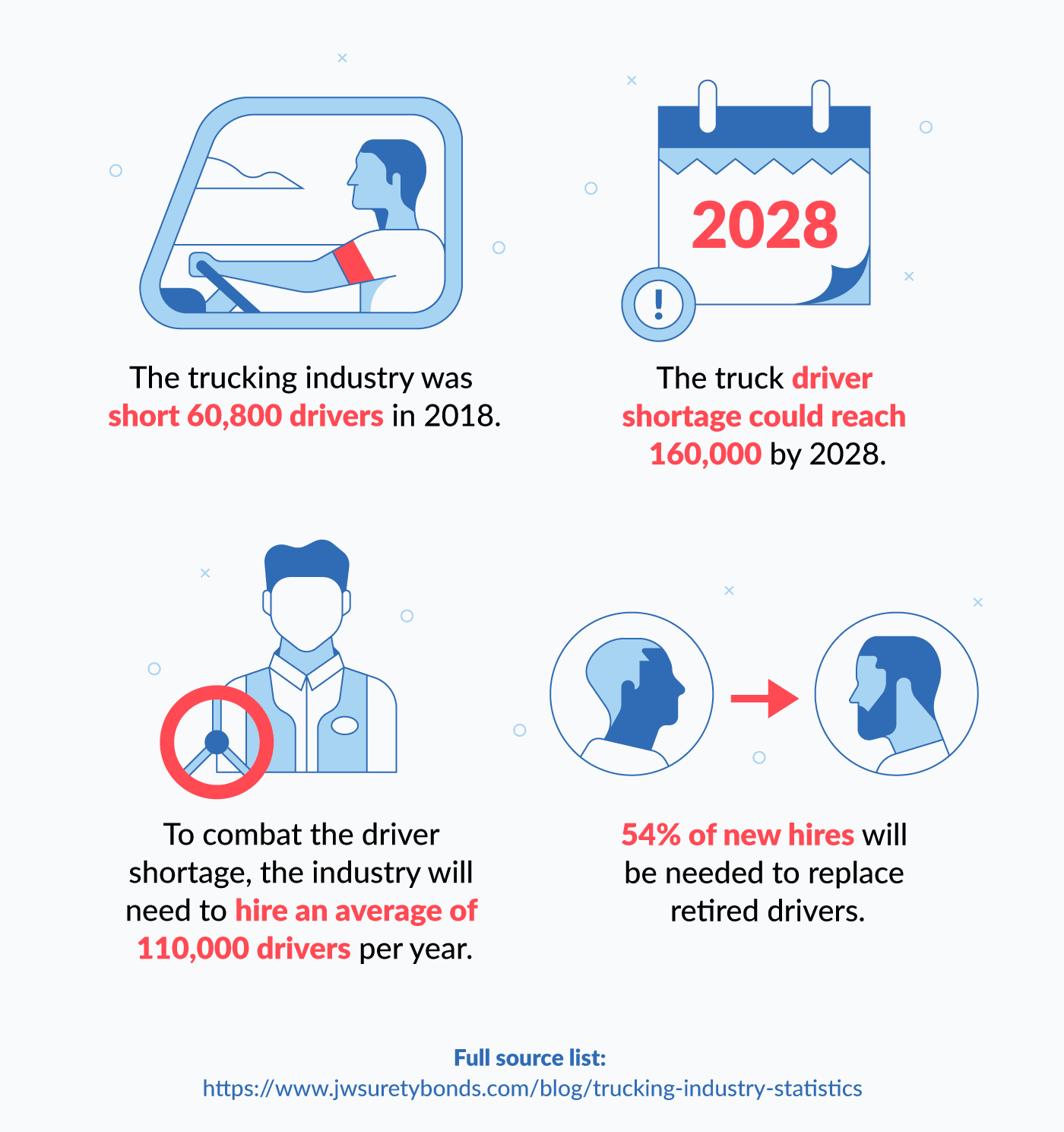
The shortage of truck drivers is one of the most pressing issues confronting the industry right now. The American Trucking Association claims that the industry has been dealing with this issue on and off since 2015. The high average age of the present workforce is one of the main reasons for the severe driver shortage.
With the average age of truck drivers nearing 46 years and higher, the industry is struggling to replace these retiring drivers. Aside from that, more businesses are prioritizing safety and are having difficulty locating certified drivers.
- The trucking industry had a driver shortage of 60,800 in 2018, a record high and a 20% increase over the previous year. (According to the American Trucking Association)
- In 2019, it was predicted that the average driver deficit will fall to 59,500. (According to the American Trucking Association)
- If current trends continue, a deficit of 160,000 people could exist by 2028. (According to the American Trucking Association)
- From 2019 to 2029, truck driver employment is expected to expand by only 2%. (According to the Bureau of Labor Statistics)
- To address the driver shortfall, the industry will need to hire around 1.1 million new drivers over the next decade, or 110,000 each year on average. (According to the American Trucking Association)
- The most significant element contributing to the driver shortage is the need to replace retiring truck drivers, which will account for 54 percent of new driver hires. (According to the American Trucking Association)
Statistics on Liabilities, Accidents, and Fleet Driver Safety
It’s no wonder that accidents and incidents occur given the number of miles fleet drivers must travel on a daily basis, as well as the long hours and difficult working circumstances they face. Over the years, there has been an upsurge in deadly collisions in the business. Distracted driving and other driver behaviors are the most common causes of these types of collisions. As a result of these accidents, trucking companies’ insurance prices have begun to rise.
With this in mind, businesses are beginning to prioritize driver safety in order to minimize potential liabilities. The driver or the company could be held accountable depending on the circumstances of the accident. If there are any problems when moving the fleet, the cargo manufacturer or loader may be held liable. A freight broker bond could protect the shipper or carrier in certain situations.
Trucking Industry Statistics on Safety
- There were 4,136 persons killed in major truck accidents in 2018. (Transportation Department of the United States of America)
- Large trucks were involved in 21% of all fatal motor vehicle collisions in 2018. (Transportation Department of the United States of America)
- Tractor trailers were involved in 74% of heavy truck crashes in 2018. (Transportation Department of the United States of America)
- In 2018, a single-unit truck was involved in 4.27 percent of heavy truck crashes. (Transportation Department of the United States of America)
- On major routes, 5. 52 percent of fatal crashes involving heavy trucks happened. (Transportation Department of the United States of America)
- On freeways and interstates, 6.33 percent of fatal crashes involving heavy trucks occurred. (Transportation Department of the United States of America)
- A fleet vehicle accident costs an average of $70,000 in damages. (Fleet of Automobiles)
- Trucking company insurance prices have risen dramatically in recent years, ranging from $12,000 to $14,000 now. (Photo courtesy of NU Property Casualty 360)
Liabilities, Accidents and Fleet Driver Safety Statistics

It’s no secret that the trucking sector employs a disproportionately male workforce. Despite the fact that it is a racially diverse sector, there has only been a two percent rise in the number of women employed in the last 18 years, and recruiting female drivers remains a challenge. In comparison to other industries, the average median income in the business is not highly competitive, which may contribute to the high turnover rate and difficulty.
- There were 3.6 million truck drivers in the United States in 2019. (American Trucking Association
- In 2019, 2. 7.95 million people worked in trucking-related jobs in the United States. (According to the American Trucking Association)
- Women make up 3.6.7 percent of truck drivers in the United States. (According to the American Trucking Association)
- Minorities account for 41.5 percent of truck drivers. (According to the American Trucking Association)
- Drivers in the trucking industry are on average 46 years old. (According to the American Trucking Association)
- Heavy and tractor-trailer truck drivers earn an average annual income of $46,370. (Source: Bureau of Labor Statistics of the United States of America)
- Light or delivery service truck drivers earn an average annual pay of $41,960. (Source: Bureau of Labor Statistics of the United States of America)
- Employees in the business earned an average hourly wage of $26.30 in July 2020. (Source: Bureau of Labor Statistics of the United States of America)
- In July 2020, the average industrial employee worked 41.2 hours per week. (Source: Bureau of Labor Statistics of the United States of America)
With the amount of miles fleet drivers have to travel daily, mixed with the long hours and hard working conditions, it’s no surprise that accidents and crashes happen. Over the years the industry has seen an increase in crashes leading to fatalities. These types of accidents usually occur from distracted driving and other driver behaviors. Trucking companies have also started to see an increase in insurance premiums due to these accidents.
With this in mind, companies are starting to take driver safety more seriously to avoid any liabilities. Depending on the circumstances around the incident, the driver or the company could be liable. The cargo manufacturer or loader could also be responsible should there be any issues when transporting fleet. In these instances, a freight broker bond could protect the shipper or carrier.
Trucking Industry Statistics on Accident & Safety
- In 2018, 4,136 people died in large truck crashes. (U.S Department of Transportation)
- 11% of all motor vehicle crash deaths that occurred in 2018 involved large trucks. (U.S Department of Transportation)
- In 2018, 74% of large truck crashes involved tractor trailers. (U.S Department of Transportation)
- 27% of large truck crashes involved a single-unit truck in 2018. (U.S Department of Transportation)
- 52% of crash deaths involving large trucks occurred on major roads. (U.S Department of Transportation)
- 33% of crash deaths involving large trucks occurred on freeways and interstates. (U.S Department of Transportation)
- The average cost of loss related to a fleet vehicle accident is $70,000.(Automotive Fleet)
- Insurance premiums for trucking companies have seen a huge spike in the last few years, totaling around $12,000 to $14,000 today. (NU Property Casualty 360)
Self-Driving Trucks and the Future of Trucking
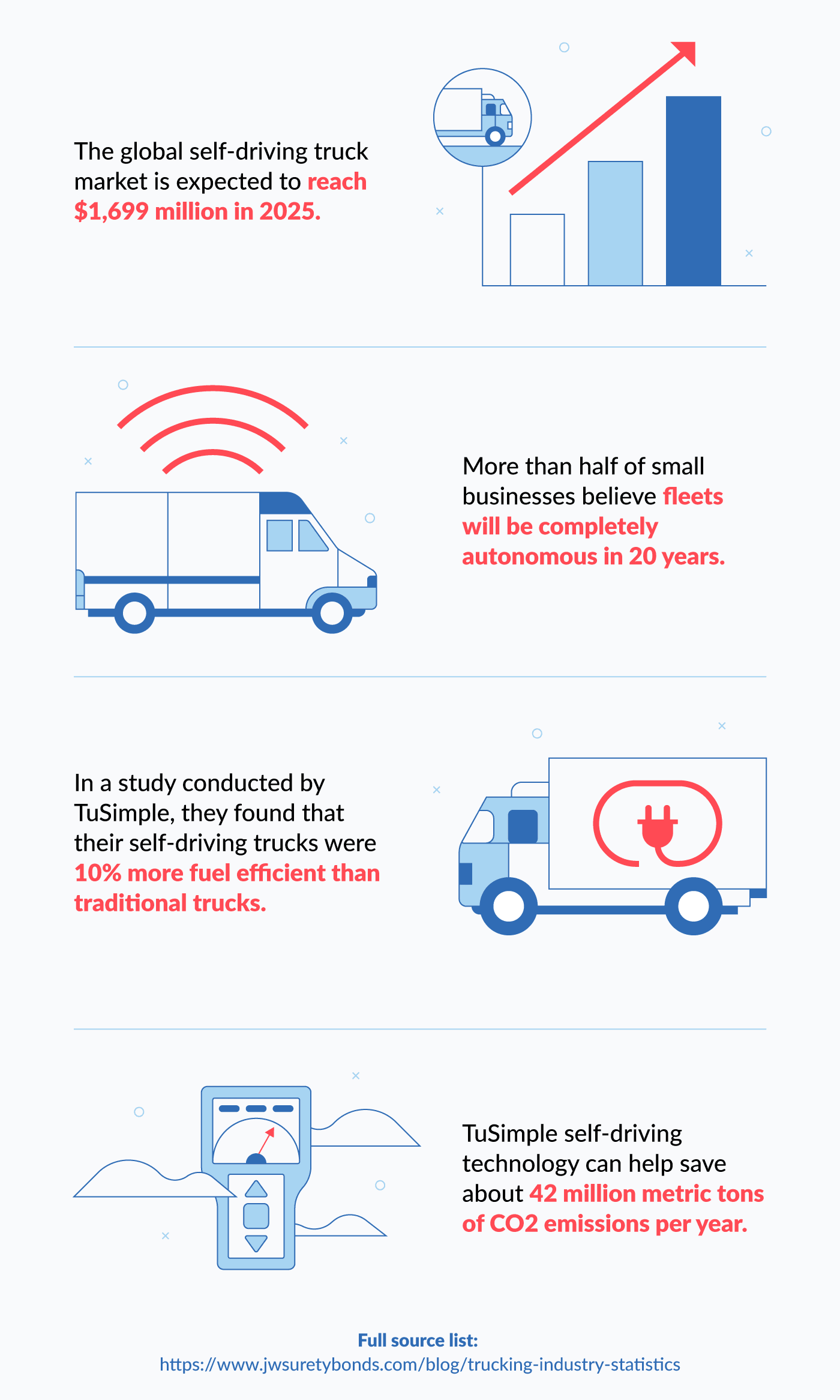
The Future of Trucking with Self-Driving Trucks
Self-driving cars have begun to make their way into the transportation industry in the United States. While some fear that this would put drivers out of work, these vehicles still require human supervision and could be a solution to the industry’s driver shortage by allowing people who would not have considered becoming a driver before to do so. Autonomous trucks may potentially reduce the likelihood of driver collisions on the road. Human error is to blame for the majority of transportation accidents, but with this technology, human error is extremely rare.
TuSimple, based in San Diego, has already begun testing its self-driving trucks and believes they will have a significant impact not just on the sector, but also on the environment. TuSimple claims that their technology will revolutionize the trucking business by lowering costs, reducing carbon emissions, and improving safety.
- The global market for self-driving trucks is estimated to reach $1,699 million by 2025. (Allied Market Research & Consulting)
- By 2025, the autonomous truck sector is predicted to increase at a compound annual growth rate of 18.6%. (Intelligence from Mordor)
- More than half of small firms expect fleets will be totally driverless in 20 years, according to a survey. Nissan Motor Corporation (Nissan) is a Japanese automobile manufacturer.
- According to the same survey, 37% of small business owners believe fleets might be totally autonomous in as short as ten years. Nissan Motor Corporation (Nissan) is a Japanese automobile manufacturer.
- According to TuSimple, their self-driving trucks are 10% more fuel efficient than standard vehicles, according to a research. (TuSimple)
- TuSimple claims that using their self-driving technology may save 42 million metric tons of CO2 each year. (TuSimple)
- Using TuSimple’s technology on all diesel trucks might save 4 billion gallons of fuel and $10 billion per year in fuel costs. (TuSimple)
Despite considerable changes in recent years, the trucking business remains one of the most profitable sectors in the country. Self-driving trucks could be the future of the trucking business, assisting in the resolution of existing issues. New technology might be frightening to a sector that has thrived for years, but accepting it can make the industry safer and contribute to a safer environment overall.
